In this post I will chronicle evidence on the real identity of Satoshi Nakamoto that I have stumbled upon over the years. I know kills the magic but I don’t care – I seek the unvarnished truth.
My leading guess is that Nick Szabo was the intellectual force behind Bitcoin and collaborated a programmer who actually wrote all the code. The programmer could have been Len Sassaman, Dave Kleiman, Hal Finney, or someone else.
As a prologue, here are some things we know about Satoshi allow us to begin to narrow our search:
- Satoshi started working on Bitcoin in 2007, registered bitcoin.org in 2008, and was active on the Cypherpunk email list where he distributed the Bitcoin whitepaper on October 31, 2008.
- On January 9, 2009, Satoshi uploaded the first version of the Bitcoin software client to SourceForge, a Windows codebase.
- Satoshi was an Anglophile, sometimes writing in British English (words like bloody, flat, maths, etc) and famously embedding a headline from UK newspaper The Times in the Bitcoin genesis block “The Times 03/Jan/2009 Chancellor on brink of second bailout for banks”
- Timestamps of code commits show that Satoshi was least active (and likely sleeping) from 11 PM- 5 AM central standard time.
- It’s likely Satoshi was a group of people. The Bitcoin whitepaper refers to “we” and there are numerous different writing styles, tones, etc. plus the multidisciplinary nature of the project coupled with the large amount of C++ code required to create it would have likely involved multiple parties
- Satoshi was burned out by Bitcoin development around July 2009 and had a day job
- Satoshi’s last communication occurred on April 23, 2011, saying “I’ve moved on to other things”
Nick Szabo
- Nick Szabo is a polymath and the inventor of the term “smart contract” and Bitcoin predecessor BitGold. This alone makes him a strong candidate.
- Bitcoin was very strongly influenced by BitGold, however it is suspiciously not listed as a reference in the Bitcoin whitepaper. Nick’s last post about Bitgold on his blog has a very similar architecture to Bitcoin
- Despite the above point, Nick wrote “Bitcoin is an implementation of the bit gold idea”
- He very briefly mentions BitCoin [sic, also note the same capitalization as BitGold, also note Sassaman called it BitCoin too] in 2009, but doesn’t really cover it in depth until 2011 (where he seems a bit defensive in response to an article). His silence during this period is suspicious, especially since he resumes posting after Satoshi’s last post, which was on December 11, 2010.
- In an email exchange with Hal Finney discussing vanity addresses, Satoshi mentions the Bitcoin address 1NSwywA5Dvuyw89sfs3oLPvLiDNGf48cPD contains his initials. NS = Nick Szabo?
- Nick wrote extensively about “trusted third parties” which is a phrase used in the Bitcoin whitepaper
- On the Tim Ferris podcast, Nick accidentally says “…I designed Bitcoi–gold…” at 1:34:20. This one’s a joke.
- Nick published the below diagram (left) of a Merkle tree 2017 which is exactly the same as the image from the Bitcoin whitepaper (right) except the “block” from the Bitcoin diagram is removed. Did Nick remove the black lines himself or did he already have this diagram handy?
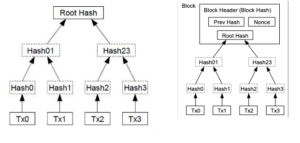
Left, posted by Szabo in 2017. Right, from Bitcoin Whitepaper
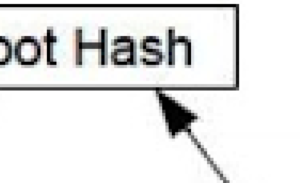
In short, few people are as qualified to be the guy. He actively sought out people to help him create a digital currency and then a pioneering digital currency appeared months later. Despite this, Nick never released a competing product or even mentioned he was working on one, and didn’t start posting about Bitcoin until after Satoshi went radio silent.
Case For Len Sassaman
This fantastic article covers a large amount of evidence which is my primary source for arguments for Len.
- Sassaman had deep technical expertise in areas such as cryptography and distributed systems
- Sassaman was involved in the cypherpunk community in San Franscisco and regularly attended industry and hackivist conferences
- Quoting the article: “Bitcoin’s Genesis Block also included a headline from that day’s copy of The Times newspaper (“The Times 03/Jan/2009 Chancellor on brink of second bailout for banks”). This headline was specific to the print version, which was only circulated in the UK and Europe. In 2009, The Times was a Top 10 newspaper in Belgium and “heavily used by scholars and researchers because of its widespread availability in libraries and its detailed index”.
- Sassaman sometimes used British English
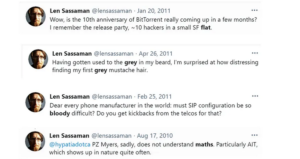
- Sassaman’s twitter activity lines up with Satoshi’s activity
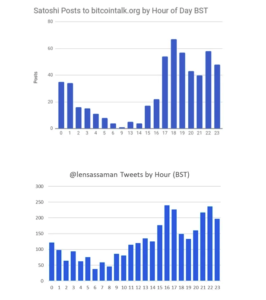
- Len’s PhD advisor at COSIC was none other than “father of digital currency” David Chaum
- Bram Cohen, a close friend of Len’s, says Len was posting anonymously on the cypherpunk mailing list and when Bram was about to release BitTorrent, Len suggested he do it anonymously
- Len tragically committed suicide in 2011, which would fit with Satoshi’s dissappearance
- Sassaman was an academic, seeking his PhD, and (subjective point) the Bitcoin codebase seems more of academic-like where the author is smart but idiosyncratic and messy as opposed to one written by a professional where they habitually follow certain coding conventions
- This paper The Pynchon Gate by Sassaman has formatting that resembles the Bitcoin Whitepaper
-
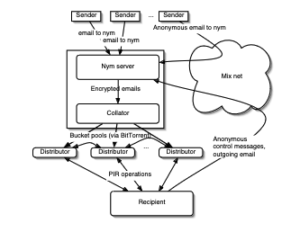
Diagram from Sassaman et al paper Pynchon Gate -

Diagram from Bitcoin Whitepaper - The Pynchon Gate shows deep expertise and interest in economics as well as relevant proto-Bitcoin technologies such as remailers,
- Sassaman had similar ideological leanings as Satoshi about politics, economics, and privacy
Case Against Len Sassaman
His wife claims to the best of her knowledge he wasn’t Satoshi. Sassaman also once tweeted “I haven’t analyzed BitCoin, but the impression of multiple digital cash experts I’ve talked to is that it’s bunk.” to which his wife replied “Bitcoin isn’t ready for prime time yet, according to its creator. Interested people can help finish it, though!” leading some to think she meant “Len is the creator of Bitcoin” although she clarified “it was my interpretation from the white paper” suggesting she was not referring to Len.
Case For Dave Kleiman
Dave Kleiman was not heavily involved in the cypherpunk scene, so the theory of him as Satoshi would involve being enlisted by his friend, Craig Wright (yes, I know lol). Dave Kleiman died in 2013 and I believe much of the evidence and keys would be lost, if not intentionally destroyed.
- Kleiman was a computer forensics expert, programmer, and privacy “enthusiast.” His expertise put him in the realm of possibility.
- Kleiman died in 2013, having spent the last few years of his life reclusively. It would make sense to me that Satoshi’s keys were lost given the massive wealth in Satoshi’s wallet and lack of communication or digital proofs appearing.
- After Kleiman’s death, his dad posted on Facebook asking for information about Dave’s involvement with Bitcoin.
- Kleiman was an expert in Windows and published forensics papers dealing with Windows. The first Bitcoin client was written for Windows.
- One of the products he worked on in his career was a “an unalterable, encrypted audit log system.”
- According to friends, Kleiman was a private guy and took digital security to the max. One friend recalled watching Kleiman routinely enter 40- and 50-character passphrases and was quoted as saying, “If you told me there was a million dollars on Dave’s computer in this room, I wouldn’t even bother trying to look for it. It would be a waste of time.”
Case Against Kleiman
Although published academic papers, the style and formatting are pretty different from the Bitcoin whitepaper, including length and extensive references. Additionally, there is simply not that much more available information for or against him.
Case For Craig Wright (aka Faketoshi? Really?)
While Wright has proven to have lied about several things relating to his involvement with Bitcoin, and is obviously not Satoshi in any meaningful way, he was involved in the cypherpunk scene at the right time and with the appropriate skills to make it possible he was involved somehow. If Kleiman was Satoshi, he likely would have been recruited by Wright.
- He was a professor of Computer Science and helped designed one of the first online casinos in 1999. Although it’s not clear he was a programmer, his skills and expertise put him in the realm of possibility as well. The original Bitcoin client also had code relating to a casino app that was never pursued.
- He was a member of the cypherpunk email list as early as 1996.
- Alleged hacked emails sent to Gizmodo between Wright and Kleiman where Wright enlists Kleiman to work on Bitcoin. The email subject is “FW: Defamation and the difficulties of law on the internet”. If you google that exact phrase in quotes, the lone result is a blog post by Wright from 2008 with the same title.
- This guy says Satoshi lives in Sydney and also claims to have helped them build Bitcoin.
- Kleiman and Wright co-authored a paper in 2008 that looks pretty similar to the Bitcoin whitepaper in formatting. That’s not terribly convincing on its own but the fact that they share a history of writing academic-type papers is something.
- Gavin Andreeson claimed “I am convinced beyond a reasonable doubt: Craig Wright is Satoshi,” although later said “It’s certainly possible I was bamboozled.”
- Satoshi used phrases like “bloody” and used British spelling at times (which is also the spelling style used in papers co-authored with Kleiman despite Kleiman being American).
Case Against Craig Wright
Wright is a liar. He has failed to provide any evidence he’s Satoshi while simultaneously suing people and claiming to be Satoshi. I am not convinced he would have the coding ability to write the Bitcoin client but I think it’s possible he could have been involved, if only in some tangential way.
Case For Hal Finney
- Hal Finney was the first adopter of Bitcoin and the first person on the cypherpunk email list to react positively to Bitcoin.
- He also had the skills, including extensive C/C++ experience, deep expertise in cryptography and distributed system.
- He was very familiar with Bitcoin’s intellectual predecessors and innovations in cryptography and digital cash and the double-spend problem
- His work and writing shared a similar ethos to Satoshi and touched on economics, liberty, privacy, distributed systems, etc.
- Hal and Satoshi exchanged emails discussing various ideas about Bitcoin, how it works, and how it could work in the future. This could be a cover for the fact that Hal was involved.
- Hal built a system that was a predecessor to Bitcoin’s proof of work called Reusable Proof of Work (RPOW).
- He mentioned that he wanted to build a poker client on top of RPOW as well as a marketplace for digital goods and the original Bitcoin client had code for both a poker app and a marketplace app which were never pursued.
- Hal published his RPOW to the cypherpunk mailing list which is how Satoshi first distributed the Bitcoin Whitepaper
- Nick Szabo described RPOW as “a variant of bit gold” and also writes about the overlaps between Bitgold and Bitcoin
- Nick Szabo cites Finney’s work in his own writing
- Hal sadly passed away in 2014, which fits with Satoshi’s lack of activity and movement of his wallet which is not worth billions of dollars
Case Against Hal Finney
Finney himself claims he was an early adopter, not the creator, which is plausible. Jameson Lopp published a report that shows Satoshi was active in posting and making Bitcoin transactions when Hal Finney was in the middle of running of a well-documented 10 mile race. However, given that Satoshi is suspected to be multiple people it doesn’t rule out him being the author of the Bitcoin codebase. One of Satoshi’s emails recently revealed says “Hal isn’t currently actively involved.” It’s not clear if this means he was never involved or no longer involved. This Twitter thread gives a number of instances where Hal Finney disagreed with Satoshi’s design or coding decisions.
Hal also contributed a lot to Bitcoin and arguably “cleaned up” the codebase over the next 1-2 years in a way that suggests someone less experienced than him wrote the first draft. In this way, you could argue Hal is more Satoshi than even Satoshi himself.
Michael Reiter
- A Reddit user seemingly at random suggests Michael Reiter is Satoshi, mostly based on his resume and relevant skills
- Reiter is deeply technical and produces a large volume of research papers in fields of cryptography, distributed systems, computer security, and other technical domains
- Reiter is cited by Nick Szabo numerous times for papers dealing with distributed systems
- A paper authored by Reiter called On Diffusing Updates in a Byzantine Environment, cites William Feller’s 1957 book “An Introduction to Probability Theory and Its Applications” as a reference. This book is also listed as a reference in the Bitcoin Whitepaper and is a bit of outlier – all other references in the Bitcoin whitepaper are from the 80-90s onward and is rather broad. This feels like a strange reference compared to the others.
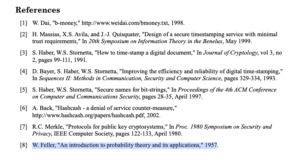
- There are some similarities in diagrams used in Reiter’s papers over time to that of the Bitcoin Whitepaper (arrows and text are very similar
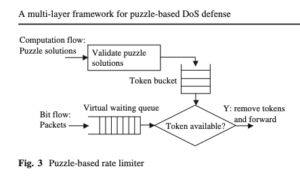
- Reiters papers sometimes have similar formatting to the Bitcoin Whitepaper, such as references being numbered surrounded by brackets e.g. [1]

- The last section of the Bitcoin whitepaper is pretty math-y, in a way that Szabo would write sometimes but it’s possible he had help from another academic type on this section of the whitepaper, if nothing else
- Reiter has a habit of having no spaces between things like “100MB” or “100KB” which also appears in the Bitcoin Whitepaper
-

Convention used by Reiter “30MBps” etc 
Conventions used in Bitcoin Whitepaper “4.2MB” etc
Case Against Michael Reiter
He produced a large volume of papers during Bitcoin’s development and when Satoshi was quite active. It’s unlikely he was heavily involved on his own given how busy he was. There is no available information indicating strong interest in economics or politics.
—
So, there you have it. I tend to think Satoshi is Nick Szabo plus Len Sassaman although it could possibly be Dave Kleiman with Craig Wright being involved on the fringes. It’s also possible this guy was involved, and there is an article that claims an anonymous source from the NSA says Satoshi is actually 4 people. It’s also worth mentioning that there just weren’t that many people involved in that scene around 2008, which means the pool of possible candidates is pretty small. Ultimately, I predict the true identities will be proven using advanced machine learning techniques that analyze text for idiosyncrasies, and the truth will become common knowledge.
Some people hate this inquiry entirely and think there’s magic in letting the mystery prevail. I personally find it more inspiring to embrace the fact that ordinary people can change the world.